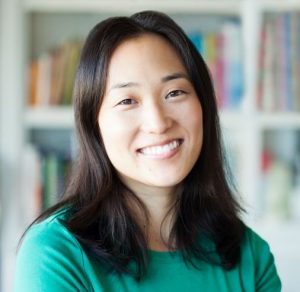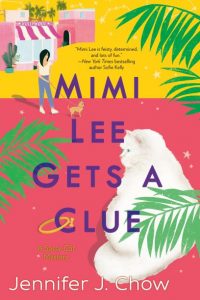Pages as Mirrors: The Need for Diverse Books by Jennifer J. Chow
 by Jennifer J. Chow
by Jennifer J. Chow
When moving to a new area, some people look for a good school district, wide paved roads, or lush green parks. One huge benefit I search for is a nearby (preferably within walking distance) library.
I’ve had a love affair with libraries ever since I was a kid. My brother and I would beg our mom to drive us to the local branch. When we got older, we would bike there. And once the city built a new branch near our home, I walked there pretty much every day.
What I admired most about reading was the opportunity to immerse myself into new worlds. Sometimes these outrageous journeys spanned space, like with A Wrinkle in Time. Other books helped me relate to animals better. For example, I loved seeing the perspective of Wilbur in Charlotte’s Web.
For the most part, though, books helped me relate to other people. Literature offered me insight into individuals living in different times under a variety of circumstances. Through Anne of Green Gables, I learned about being an orphan girl in rural Prince Edward Island. I felt the connection of sisterhood and experienced the Civil War period by reading Little Women. And, of course, I solved mysteries alongside the affluent and independent-minded Nancy Drew. Books acted as windows into other people’s lives.
However, for a long time, the converse didn’t hold true; books didn’t offer much insight for others to understand my background. And sometimes they ended up creating barriers instead.
As a very young child, I remember our class reading the picture book, Tikki Tikki Tembo. In the story, there are two Chinese bothers (though this folktale might actually have Japanese origins). The younger boy, named Chang (which isn’t a first name and certainly doesn’t mean “little”), falls into the well but is rescued quickly because of his short name. His older brother, Tikki Tikki Tembo (plus a long string of nonsensical sounds) also falls into the well but is unable to get help quickly because it takes so long to say his name.
I remember my classmates turning and looking at me after reading the book. A few of them even started using “Tikki” as a nickname for me. Others commented on my short last name. I hadn’t realized how “other” or foreign I had appeared to them until then. Yes, I was American and born in the United States, but I must have looked different.
As I got older, peers continued to address my background and appearance. Some people wanted to seem worldly and tossed Japanese and Korean phrases my way. A few did use Mandarin Chinese (but I spoke Cantonese).
I also dealt with taunting. I’d be called “Ching-Chong” or people would start speaking gobbledygook to me. A few classmates pulled at their eyes to make them “slanted.” For a period of time, I wished I could change my appearance, particularly my skin color and facial features. I longed to be accepted, or left alone at least.
All their negative comments made me question my cultural identity. I have roots in both Malaysia and China. While growing up, traditions in my family included handing out lucky red envelopes, burning incense, and eating mooncakes. When the Thanksgiving holidays rolled around, we also ate turkey—stuffed with sticky rice. I slowly understood I was a mishmash of cultures…but was that okay? Or odd?
It was, naturally, the library that saved me. One fine May, I noticed a special rack of books selected for Asian American and Pacific Islander Heritage Month. There, I discovered Dale Furatani’s samurai mystery books. An Asian American writer? I’d never heard of one before.
I was so excited that he wrote about his heritage in his stories. Moreover, the library had celebrated him for doing so and had put his books on display. Maybe being part of dual cultures wasn’t so bad and could even be worthy of recognition.
Later still, I remembered reading excerpts from Amy Tan’s The Joy Luck Club as required reading in English class. She captured the tension of being caught between Chinese and American culture. I felt like she recognized my struggles. In turn, I hoped that my classmates might also understand me better. I realized then that books had the power to be not only windows, but mirrors.
I wish I could’ve seen more examples of appropriate Asian-inspired books while growing up. It would have boosted my self-identity in a positive way.
However, I’m really grateful for authors like Grace Lin, who are paving the way for kids today. In Dumpling Days, she explores the complicated feelings of what it’s like to travel overseas to a new country where you’re supposed to have roots. I’m also thankful for Lisa Yee, who ended up flipping the model minority myth and creating a basketball-loving Asian American boy in Stanford Wong Flunks Big-Time. I really hope that the next generation will not have to struggle with intense feelings of shame like I did.
I believe it’s imperative that we have movements such as We Need Diverse Books. Literature should offer a full range of works that depicts diversity in all its glory. I’m also proud to be a part of a growing movement to diversify mysteries—just look at all the wonderful authors on Frankie’s List. Plus, I’m thankful for the opportunity to create characters like the Malaysian Chinese mother in my own upcoming novel, Mimi Lee Gets a Clue.
Furthermore, I’m indebted to libraries for making these beautiful and much-needed books accessible to all.
—
Jennifer J. Chow’s novel, Mimi Lee Gets a Clue, is the first in the new Sassy Cat mystery series. Her other Asian-American novels include Dragonfly Dreams, The 228 Legacy, andthe Winston Wong cozy mysteries. She lives in Los Angeles and is active in Crime Writers of Color and Sisters in Crime.
Connect with her online at www.jenniferjchow.com
social media
MIMI LEE GETS A CLUE
 Mimi Lee is in over her head. There’s her new Los Angeles pet grooming shop to run, her matchmaking mother to thwart, her talking cat Marshmallow to tend to—oh, and the murder of a local breeder to solve…now if only Mimi hadn’t landed herself on top of the suspect list.
Mimi Lee is in over her head. There’s her new Los Angeles pet grooming shop to run, her matchmaking mother to thwart, her talking cat Marshmallow to tend to—oh, and the murder of a local breeder to solve…now if only Mimi hadn’t landed herself on top of the suspect list. Category: Contemporary Women Writers, How To and Tips























